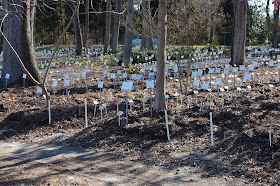Soon after I got back I got an email from Helen Yoest in Raleigh, NC, with a book review about this very issue. http://www.nybooks.com/articles/archives/2013/feb/21/visitors/?pagination=falseHow the woods are reclaiming the suburbs and the wildlife problems that result, or is it the suburbs invading the woods? Interesting stuff, and something which follows on from my recent blog with the rather lurid Martha Schwartz quote. The first few generations of European settlers felled every tree in sight, farmed, then realised that much of the land was too poor, and moved west, to plough up the much more fertile prairie. The woodland fought back. Very successfully. Whereas in Britain, woodland re-establishes itself through a fairly slow process, in the US, I feel that if all human beings disappeared one day (selective gamma ray burst that leaves other species standing?), then ten years later there would almost be no trace left of their presence. Trees re-establish so quickly. The upshot is that much of the area where people live is actually forest: roads, houses, gardens etc. are carved out of the forest. The wildlife, deer especially, have bounced back from the days when they hunted by anyone and everyone, to enormous numbers, numbers which in the absence of enough predators (i.e. not enough coyotes, bears, wolves, guys with guns who can shoot straight) have rocketed. Not good for gardeners, not actually very good for the environment, or even for the health of deer populations. For much of the wildlife, humanity is no longer a threat, but a source of food and habitat.
I am reminded of the British equivalent, the urban fox; cities support far more foxes than the countryside - all those bins to raid, discarded take-away meals, food left out for hedgehogs etc. No longer afraid, the wild animals creep back. Except that having exterminated all the big predators centuries ago (wolves, wild cats, bears, lynx) the urban wildlife we have is very unbalanced. Bring back the wolf? except that the farmers would complain (more than farmers complain anyway) and I somehow don't see large predators being welcome in British cities and suburbs.
Deer clearly need intelligent culling, and a more natural source of meat cannot be imagined. But in both the US and Britain, any mention of a cull brings storms of protest - often from people who are quite happy to sit down and eat meat from farmed animals. Another symptom of a failure to engage with the realities of life on earth.
What is so strange about this suburban woodland which so many US citizens choose to live in, is the extreme contrast with areas deemed to be landscaped: the vast deserts of grass mown to within an inch of its life, the extensive mulchscape which surround 'plantings' of evergreen shrubs ruthlessly pruned into meatballs. Much US landscaping and its management seems to express almost a hatred of vegetation, or as often with hatred, is it really fear (as with misogynist men). Or is it just job-creation? In the land of the ruthless corporate downsize, it seems strange that so many hands are paid to keep doing what is so apparently pointless. At one stage I got talking to a guy who worked as a landscape architect, he was fairly new into his career and was clearly on the bottom rung, designing landscapes for MacDonalds outlets etc.; he had almost no room for creativity - local zoning/planning requirements are incredibly prescriptive about how many shrubs had to be planted, what size, spacing etc. Driving through the junkscape outside Raleigh: endless auto retail outlets, strip malls, fast food outlets, box stores, made me feel very depressed. Such waste of space, such mediocrity on an epic scale, such obsession with control, above all the CONFORMITY. The conformity that we expected from Soviet communism, but which these supposedly free citizens embraced.
Will it ever change? I thought about the various people over the years I have met who have fought for the right to grow meadow or prairie in their front yards. It is a battle that is still being fought, against the totalitarian instincts of lawn ordinances and neighbourhood associations. Thinking of the Highline, and the other projects which it is beginning to inspire which embrace wildness, I realised that it may be a very slow process, but things are changing. And - that I, with my writing and lecturing, am part of this process. My first American lecture tour was in 1996, as part of a group, organised by Horticulture magazine and called 'Wild Style'. My realisation made me feel less depressed, and left me with a strange feeling of subversive power; I, chuntering down the freeway in my anonymous rental Ford Fiesta (BTW Ford have a green roof on their Dearborn, MI, plant) am doing something about this. The ability of nature to take back lost ground is so obvious here, much more so than at home, it only needs permission. Let's give it, but remember, it will have some consequences which we need to be brave and sensible about.






















